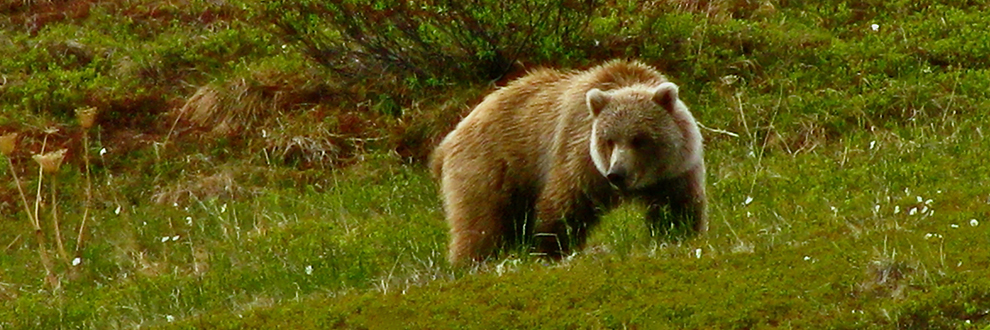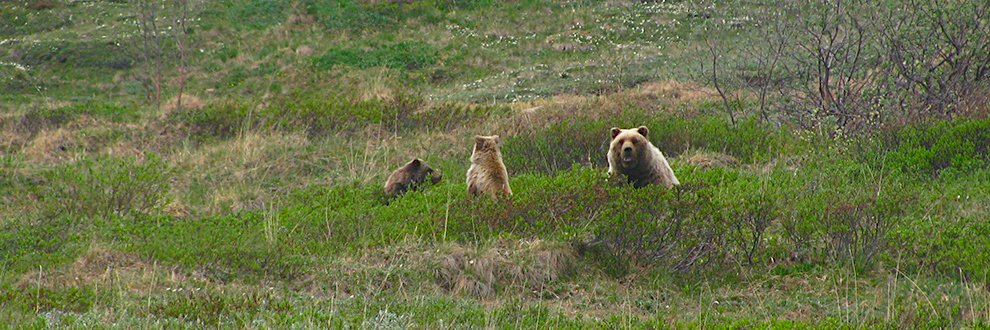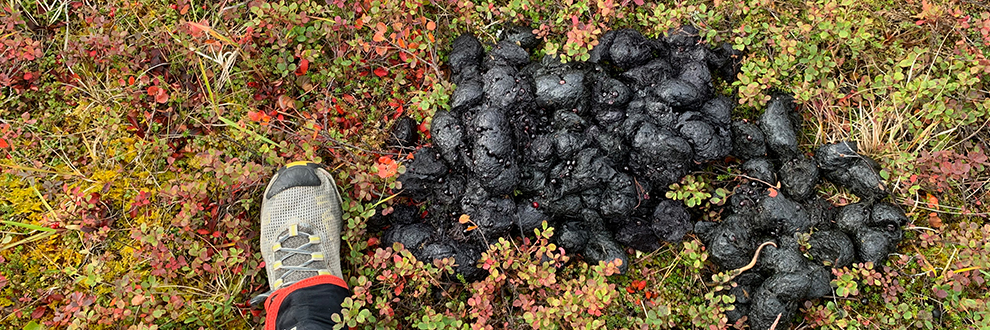06 Mar Bears, Bugs + Bathrooms Pt 1 – Bear Safety
BEARS, BUGS AND BATHROOMS (OR LACK THEREOF) – ANOTHER 3 PART SERIES
That’s right folks we’re talking about the scary, annoying and literally shitty elements of backcountry travel in Alaska. There are three main questions we receive from potential guests:
- What about bears?
- How bad will the bugs be?
- What is the bathroom situation?
Today, we’re starting with the question we get most often – “What about bears?”

Seeing bears in the wild is one of the most amazing parts of backcountry travel in Alaska. But it is also one of the topics that gives adventurers serious anxiety. Our hope is that this brief tutorial on traveling in bear country helps calm some of that anxiety and give you the tools you need to travel confidently. Whether you go on a Tundra Travels trip or not, we’re stoked to help all backcountry travelers move safely through bear country.
Alaska is home to black, brown (grizzly) and polar bears and at least one of these species can be found almost anywhere in Alaska, except in most of the Aleutians and some other remote islands. The advice here is for traveling in black and brown bear country. Polar bears come with their own unique set of bear safety protocols. And the average person is very unlikely to encounter a polar bear unless they are actively seeking to do so.
Note: If you are interested in seeing polar bears we recommend a trip to Kaktovik – a very cool community located on Barter Island just north of the Arctic National Wildlife Refuge. Look for a tour led by a member of the Alaska Native community there like Akook Arctic Adventures or Kaktovik Arctic Adventures.
Here are four basic guidelines for traveling in bear country:
- Remember that bears typically want to avoid you as much or more than you want to avoid them.
- Take preventative measures to avoid negative bear encounters – we’ll go into detail on these below.
- Learn about bear behavior so you know what a curious, predatory or defensive bear looks like.
- Carry a bear deterrent – again, lots of options and details on this below.
#1 REMEMBER THAT BEARS TYPICALLY WANT TO AVOID YOU AS MUCH OR MORE THAN YOU WANT TO AVOID THEM.
Seriously, the vast majority of the bears we see make every attempt to avoid us and go about their lives. Bears are largely vegetarian creatures that are on a summer long mission to consume enough calories to get through their winter hibernation. There was a very cool Alaska Department of Fish and Game program that placed video collars on black and brown bears in the Anchorage area. These bears saw lots of humans that never saw them. However many bears I’ve seen in the Alaskan backcountry, I multiply that by 10 and assume that is how many bears have seen me.
Even though bears typically want to avoid us in the backcountry we should do everything we can to…
#2 TAKE PREVENTATIVE MEASURES TO AVOID NEGATIVE BEAR ENCOUNTERS.
These preventative measures start at home. Leave the scented hygiene products in the front country, package your food in bear resistant food containers(BRFCs) and plan a route that minimizes the time you spend in areas with limited visibility or high bear density. For example, leave the brush and head for the alpine if you can and maybe don’t plan to camp in a known salmon spawning area during the spawn. And invite some friends – there has never been a documented bear attack on a cohesive group of 4 or more. Traveling solo or in small groups can still be safe, but be sure to follow all other preventative measures.
Once you’re in the backcountry make good bear decisions as you travel, cook and camp. If you’re traveling somewhere with poor sight lines – such as dense vegetation – make plenty of noise. Singing, shouting or clapping your trekking poles together works well. Stay within sight and sound of the other members of your group so that if you do encounter a bear you can react together. When you’re cooking make sure someone is aware of your surroundings and keeping an eye out for approaching wildlife. Cook at least 100 yards away from where you plan to sleep. Before you go to sleep at night check all pockets for wrappers, snacks, etc. Brush your teeth, wash up, etc away from your sleep zone and make sure that all food, scented hygiene items and trash are properly stored in a BRFC. Overnight store your BRFC at least 100 yards away from your sleeping area and your cooking location.
If you follow preventative measures you should be able to avoid most negative bear encounters. But if you do encounter a bear it is good to understand their behavior, which brings us to….

#3 LEARN ABOUT BEAR BEHAVIOR SO YOU KNOW WHAT A CURIOUS, PREDATORY OR DEFENSIVE BEAR LOOKS LIKE.
Understanding bear behavior helps us coexist with these bruins in the backcountry. This is a great reason to go with a guide as experienced backcountry guides in Alaska have a solid understanding of bear behavior. How we react to a bear depends on how that bear is acting. One thing is true across all behavior types – NEVER RUN FROM A BEAR. Four types of behavior to be aware of are:
Indifferent or Unaware – Congratulations! You’re witnessing a bear that is either wholly apathetic to your existence, or better yet, doesn’t even know that you’re there. If necessary, slowly move away from the bear and once you are a safe distance away, you can watch this bear until its behavior changes, it leaves the area or you leave the area. There is no need to yell or notify this bear of your existence. But do keep an eye out for any changes in this bear’s behavior – especially if it suddenly realizes that you are present or if it starts approaching you.
Curious – Bears are naturally curious and they’re at the top of the food chain, so they don’t have many deterrents to exploring that curiosity. A curious bear may inspect scents, noises and objects to determine if they are edible or something to play with. A curious bear may stand up on its hind legs to allow it to get more information about the situation. We want to show curious bears that we’re big, we’re not food but we’re also non threatening. Appropriate reactions to a curious bear including stopping and calmly identify ourselves as human by talking to the bear. We might group together, slowly wave our arms in the air to look bigger. If possible we might move upwind to let the bear smell us.
Threatened or Defensive – A threatened bear may be surprised or feel that its personal space, food or the safety of their cubs are at risk. Signs of a threatened bear include a pause in activity, a stiffening stance or other change in posture, huffing, other vocalizations and jaw popping. These behaviors may progress to salivating, rapid huffing, roaring, paw swatting, guttural sounds and charges. We want to show threatened bears that we are not a threat. This may involve speaking softly, while backing away and leaving the area slowly. If a defensive bear gets closer we may use our bear spray. In the very unlikely event that a defensive bear makes contact, you should immediately drop to the ground and play dead, curling into the fetal position and covering your head and neck. A backpack can help protect you in this rare scenario.
Predatory – A predatory bear is currently neither surprised nor scared. This is a bear that has identified you as prey. A predatory bear will likely not be defending itself, a food source or its young. It may follow or circle you for a long time, gradually approaching. A predatory bear may act very interested and deliberately approach without displaying the stress behaviors listed above. We want to aggressively defend ourselves against predatory bears. To deter a predatory bear we may aggressively shout, look big, wave our arms, throw rocks, etc. In the event that a predatory bear makes contact, aggressively fight back and defend yourself with anything at your disposal. Your bear deterrent should be ready to deploy at all times which reminds us to…
#4 ALWAYS CARRY A BEAR DETERRENT.
Keep in mind that all bear deterrents (bear bangers, bear spray, firearms, air horns, etc) have their advantages and their downsides. But the best bear deterrent for you is the one you know how to use. It’s relatively easy to learn how to use bear spray. A handgun or shotgun is also a reasonable deterrent – in part due to its ability to make a very loud noise that may scare away a bear. But if you aren’t very proficient with a firearm, extremely cool under pressure and carrying a firearm of sufficient caliber it may not be effective at all.
We travel extensively in bear country and almost exclusively use bear spray. We have also carried flares, “bear bangers” and in rare cases a firearm, but in most circumstances, our guides do not carry firearms on our trips. Guests are not allowed to bring firearms on trips under any circumstances. Every single person on all of our trips is issued a bear spray canister and given instruction on how to use it. This is an important distinction – the bear spray that your friend has sitting next to them by their tent does you no good if you’re 100 yards away going to the bathroom – always carry your own.
Phew! To recap, bears are amazing and we hope to see them in the wild, from a distance. It can be reassuring to remember that typically they want nothing to do with people. Always practice preventative measures to avoid negative bear encounters. Brush up on your understanding of how a curious, threatened or predatory bear behaves so that you know how to react when you do see a bear. And always carry a bear deterrent that you know how to use. We hope this helps you adventure confidently in bear country – either independently or on a Tundra Travels trip! Of course if you have any questions, don’t hesitate to reach out in the comments or on our contact page. ✌️-Haley
PS – Since you made it this far – here is a photo of the largest pile of bear shit I’ve ever seen! Foot for scale – that’s a lot of poop!




No Comments